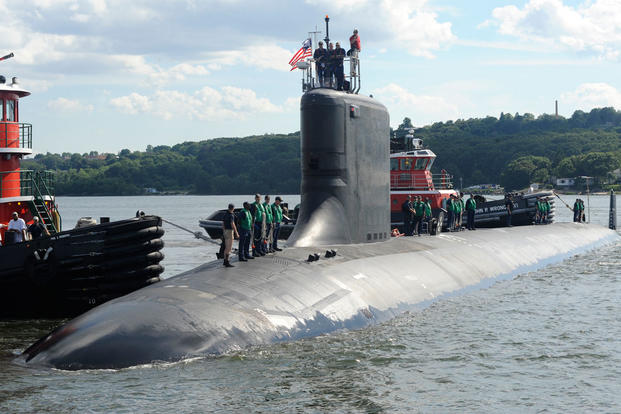The Navy is evaluating whether it can add 28 more Tomahawk missiles to each Virginia-class submarine sooner than expected, service leaders said.
The service plans to begin production of what's called Virginia Payload Modules, or VPM, onto Block V submarines by 2019 -- a move which would add a new section of missile tubes to the ship and increase its ability to fire Tomahawk missiles from 12 up to 40, said Navy Capt. David Goggins, Virginia-class submarine program manager.
An evaluation is currently underway to assess the feasibility of adding VPM ahead of the current schedule and engineering them onto Block IV Virginia-class submarines being built earlier than 2019. A decision is expected by next month or May, Goggins said.
Speaking to lawmakers during Congressional Navy budget hearings, Navy Secretary Ray Mabus and Chief of Naval Operations Adm. Jonathan Greenert have both indicated that deliberations about possibly accelerating VPM production were currently underway.
Navy engineers have been working on requirements and early designs for a new, 70-foot module for the Virginia-class submarines engineered to house an additional 28 Tomahawk missiles. While designed primarily to hold Tomahawks, the VPM missile tubes are engineered such that they could accommodate a new payload, new missile or even a large unmanned underwater vehicle, Navy officials said.
From 2002 to 2008 the Navy modified four of its oldest nuclear-armed Ohio-class submarines by turning them into ships armed with only conventional missiles -- the USS Ohio, USS Michigan, USS Florida and USS Georgia. They are called SSGNs, with the "G" designation for "guided missile."
"When the SSGNs retire in the 2020s – if no action is taken the Navy will lose about 60-percent of its undersea strike launchers. When we design and build VPM and start construction in 2019, that 60-percent shortfall will become a 40-percent shortfall in the 2028 timeframe. Over time as you build VPM you will eliminate the loss of firepower. The rationale for accelerating VPM is to potentially mitigate that 40-percent to a lower number," Goggins explained.
Virginia-class submarines, engineered to replace the 1980s-era Los Angeles-class attack submarines, are being built in block increments. Blocks I and II, totaling 10 ships, have already been delivered to the Navy. Block III boats are currently under construction. In fact the first Block III boat, the USS North Dakota, was delivered ahead of schedule in August of last year.
The first several Block IV Virginia-class submarines are under construction as well -- the USS Vermont and the USS Oregon. Last April, the Navy awarded General Dynamics' Electric Boat and Huntington Ingalls Industries Newport News Shipbuilding a $17.6 billion deal to build 10 Block IV subs with the final boat procured in 2023.
Also, design changes to the ship, including a change in the materials used for the submarines' propulsor, will enable Block IV boats to serve for as long as 96-months between depots visits or scheduled maintenance availabilities, Goggins explained.
As a result, the operations and maintenance costs of Block IV Virginia-class submarines will be much lower and the ships will be able to complete an additional deployment throughout their service live. This will bring the number of operational deployments for Virginia-class submarines from 14 up to 15, Goggins explained.
Blocks I and II, totaling 10 ships, have already been delivered to the Navy. All eight Block III boats are being built under a $14 billion Navy deal with General Dynamics' Electric Boat from December of 2008.
The Block III Virginia-class subs are built with new so-called Virginia Payload Tubes designed to lower costs and increase missile-firing payload possibilities, Navy officials explained.
Instead of building what most existing Virginia-class submarines have — 12 individual 21-inch in diameter vertical launch tubes able to fire Tomahawk missiles — the Block III submarines are being built with two-larger 87-inch diameter tubes able to house six Tomahawk missiles each.
"With the Virginia Payload Modules, we're adding a body section that will house four additional Virginia Payload Tubes. That will allow you to go from 12 to 40 Tomahawks – that is the main driver or requirement for this new module," Goggins said.
Goggins added that Navy engineers are also working on various hydraulic pumps needed to support the additional weapons and strike capability. The new Virginia Payload Modules are being engineered to fire the Tomahawk missile and also accommodate future weapons as they emerge, he added.
"We will have the flexibility to house a range of weapons that were too big to fit in our existing VLS tubes. We have inherent flexibility. As new payloads become available and as the demand and threat environment change – we will have the flexibility to adapt future payloads," he said.
Ultimately, the Navy plans to build as many as 20-ships with VPM, a plan that will bring production of Virginia-class submarines out through 2033 and bring the overall fleet size up to 51 ships, Goggins explained. The soon to be released 2016 Navy 30-year Shipbuilding Plan will specify the timelines for this, he added.
Since the expected service life of a Virginia-class submarine is 33 years, the ships will be expected serve well beyond 2060.
All Virginia-class submarines are also engineered with a computerized fly-by-wire touchscreen control system wherein boat operators use a joystick to navigate, unlike the mechanical hydraulic controls used on prior models.
Also, the Block III boats and beyond will also have a Large Aperture Bow array which places a conformal sonar system in the bow of the boat, Navy officials said.
"The LAB array provides improved passive listening capabilities over traditional spherical arrays employed on earlier submarines," Rear Adm. Joseph Tofalo, director of undersea warfare, said in a written statement last year. "The LAB array includes a medium-frequency active array. The hydrophones used to determine a bearing of either incoming passive sounds or active reflected sounds are taken directly from previous design and technology advancements."
-- Kris Osborn can be reached at kris.osborn@military.com


























